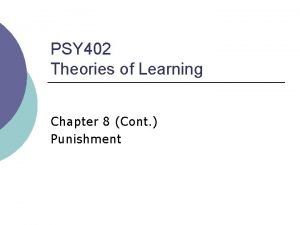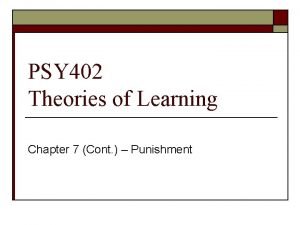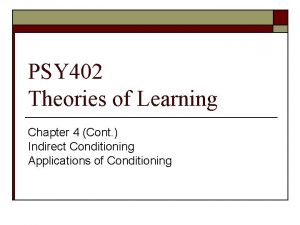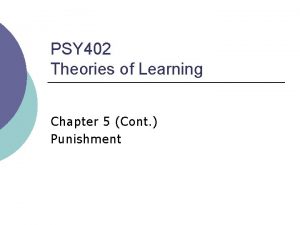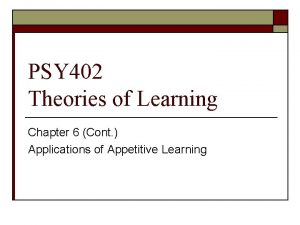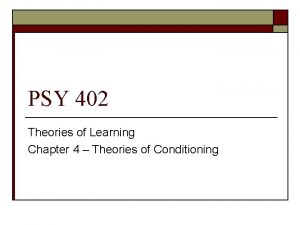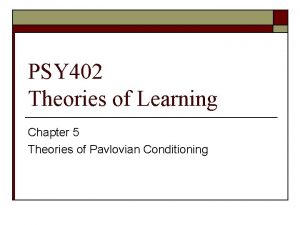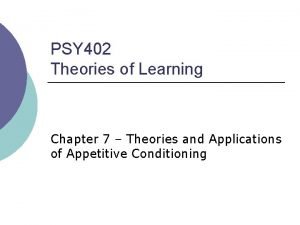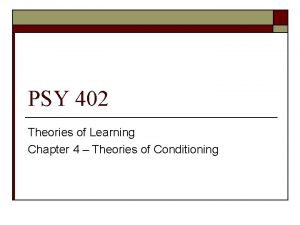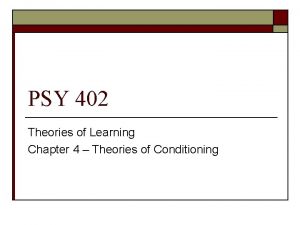PSY 402 Theories of Learning Chapter 8 Cont















- Slides: 15

PSY 402 Theories of Learning Chapter 8 (Cont. ) Punishment

Punishment ¡ Use of an aversive event contingent on the occurrence of an inappropriate behavior. l ¡ Used to suppress undesired behavior. If effective, frequency or intensity (or both) of behavior decreases.

Types of Punishers Positive punishment – use of a physically or psychologically painful event as a punisher. ¡ Negative punishment – loss of reinforcement as a consequence of an inappropriate behavior. ¡ l Also called omission training – reinforcement is provided when an undesirable behavior is withheld.

Positive reinforcement adds a good thing Negative reinforcement removes bad thing Increases Reinforcement + Behavior Consequences Punishment Reduces Punishment adds a bad thing Response cost removes good thing

Four Kinds of Consequences Positive Stimulus Negative Stimulus (Add) (Subtract) Increase Behavior Decrease Behavior Positive Reinforcement Negative Reinforcement Bonus for working hard leads to more hard work Headache gone after aspirin leads to more aspirin use Positive Punishment Negative Punishment Getting speeding ticket leads to less speeding Missing dinner leads to less staying out late

Types of Negative Punishment ¡ Response cost – an undesirable behavior results in withdrawal of reward or failure to attain reward. l ¡ Example: loss of privileges Time-out – a period of time during which reinforcement is unavailable. l Example: being sent to room after misbehaving.

Does Punishment Work? Skinner showed that punishment only temporarily suppresses behavior. ¡ More recent studies show that it can permanently suppress behavior under some conditions. ¡ Under other conditions it has no effect or only temporarily works. ¡

Severity of Punishment ¡ Mild punishment doesn’t work. l Example: Drunk drivers do it again. With mild punishment, any suppression is short-lived. ¡ The more severe the punishment, the longer it works. ¡ l ¡ Example: sale of cigarettes to minors. Must be severe to accomplish permanent behavior change.

Consistency of Punishment ¡ Punishment must be consistently administered. l l l Odds of a drunk driver being caught are 1 in 2000. Suppression increases as the frequency of punishment increases. Delinquent boys more likely to have parents who are inconsistent in their discipline.

Delay of Punishment ¡ Punishment must be immediate in order to be effective. l Long delay between arrest and trial for drunk drivers.

Drawbacks to Using Punishment ¡ Pain-induced aggression – pain elicits anger which may motivate aggressive behavior. l ¡ An impulsive act energized by emotional arousal, not avoidance. Modeling of aggression – children may imitate a parent’s aggressive acts through observational learning. l Bandura’s Bobo doll study

Conditioning of Fear ¡ The aversive quality of punishment may condition a fear response to the person administering it. l ¡ Person will try to escape the punisher. Use of reinforcement together with punishment prevents this association. l Children do not learn to fear a behavior therapist who uses electric shock.

More Drawbacks ¡ Suppressive effects may generalize from an undesirable behavior to other desirable behaviors. l ¡ Punishment may not generalize to similar undesirable behaviors. The person may not recognize the contingency between the behavior and the punishment.

Applications of Punishment Widespread use of punishment (e. g. , spanking) probably does not serious harm. ¡ Two applications: ¡ l l ¡ Persistent vomiting decreased. Tree-climbing behavior suppressed. Use of such punishment may be preferable to ineffective methods.

Ethical Use of Punishment Cruel and unusual punishments prohibited by 8 th Amendment of US Constitution. ¡ Rights of individual must be safeguarded. ¡ l l ¡ APA Ethical Principles of Psychologists Least restrictive alternative Balance punisher pain against pain if the behavior is left untreated.
